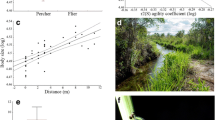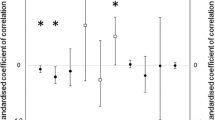Abstract
In Odonata, many species present sexual size dimorphism (SSD), which can be associated with male territoriality in Zygoptera. We hypothesized that in the territorial damselfly Argia reclusa, male–male competition can favor large males, and consequently, drive selection pressures to generate male-biased SSD. The study was performed at a small stream in southeastern Brazil. Males were marked, and we measured body size and assessed the quality of territories. We tested if larger territorial males (a) defended the best territories (those with more male intrusions and visiting females), (b) won more fights, and (c) mated more. Couples were collected and measured to show the occurrence of sexual size dimorphism. Results indicated that males are larger than females, and that territorial males were larger than non-territorial males. Larger territorial males won more fights and defended the best territories. There was no difference between the mating success of large territorial and small non-territorial males. Although our findings suggest that male territoriality may play a significant role on the evolution of sexual size dimorphism in A. reclusa, we suggest that other factors should also be considered to explain the evolution of SSD in damselflies, since non-territorial males are also capable of acquiring mates.


Similar content being viewed by others
References
Alcock J (1979) Multiple mating in Calopteryx maculata (Odonata: Calopterygidae) and the advantage of non-contact guarding by males. J Nat His 13:439–446
Alcock J, Houston TF (1996) Mating systems and male size in Australian Hylaeine bees (Hymenoptera: Colletidae). Ethology 102:591–610
Alcock J (2000) Possible causes of variation in territory tenure in a lekking Pompilid wasp (Hemipepsis ustulata) (Hymenoptera). J Insect Behav 13:439–453
Altmman J (1974) Observational study of behaviour: sampling methods. Behaviour 49:227–265
Bart J, Earnst SL (1999) Relative importance of male and territory quality in pairing success of male rock ptarmigan (Lagopus mutus). Behav Ecol Sociobiol 45:355–359
Bick GH, Bick JC (1965) Demography and behaviour of the damselfly, Argia apicalis (Say), (Odonata: Coenagriidae). Ecology 46:461–472
Borgia G (1982) Experimental change in resource structure and male density: size-related differences in mating success among males of Scatophaga stercoraria. Evolution 36:307–315
Candolin U, Voigt HR (2001) Correlation between male size and territory quality: consequence of male competition or predation risk? Oikos 95:225–230
Conrad KF (1992) Relationships of larval phenology and imaginal size to male pairing success in Argia vivida Hagen (Zygoptera: Coenagrionidae). Odonatologica 21:213–222
Contreras-Garduño J, Buzatto B, Serrano-Meneses MA, Nájera-Cordero K, Córdoba-Aguilar A (2008) The size of the wing red spot as a heightened condition dependent trait in the American rubyspot. Behav Ecol 19:724–732
Corbet PS (1999) Dragonflies behaviour and ecology of Odonata. Harley, Essex
Córdoba Aguilar A (2009) Seasonal variation in genital and body size, sperm displacement ability, female mating rate, and male harassment in two calopterygid damselflies (Odonata: Calopterygidae). Biol J Linn Soc 96:815–829
Córdoba-Aguilar A, Raihani G, Serrano-Meneses MA, Contreras-Garduño J (2009) The lek mating system of Hetaerina damselflies. Behaviour 146:189–207
De Block M, Stoks R (2007) Flight-related body morphology shapes mating success in a damselfly. Anim Behav 74:1093–1098
Fincke OM (1984) Giant damselflies in a tropical forest: reproductive biology of Megaloprepus coerulatus with notes on Mecistogaster (Zygoptera: Pseudostigmatidae). Advances in Odonatology 2:13–27
Forsyth A, Montgomerie RD (1987) Alternative reproductive tactics in the territorial damselfly Calopteryx maculata: sneaking by older males. Behav Ecol Sociobiol 21:73–81
Gribbin SD, Thompson DJ (1991) Egg size and clutch size in females of the damselfly Pyrrhosoma nymphula (Sulzer) (Zygoptera: Coenagrionidae). Odonatologica 19:347–357
Guillermo-Ferreira R, Del-Claro K (2011) Resource defense polygyny by Hetaerina rosea Selys (Odonata: Calopterygidae): influence of age and wing pigmentation. Neotrop Entomol 40:78–84
Johansson F, Rowe L (1999) Life history and behavioral responses to time constraints in a damselfly. Ecology 80:1242–252
Koenig W (1990) Territory size and duration in the white-tailed skimmer Plathemis Lydia (Odonata: Libellulidae). J Anim Ecol 59:317–333
Kratochvíl L, Frynta D (2002) Body size, male combat and the evolution of sexual dimorphism in eublepharid geckos (Squamata: Eublepharidae). Biol J Linn Soc 76:303–314
Kuwamura T, Karino K, Nakashima Y (2000) Male morphological characteristics and mating success in a protogynous coral reef fish, Halichoeres melanurus. J Ethol 18:17–23
Miller PL (1983) The duration of copulation correlates with other aspects of mating behaviour in Orthetrum chrysostigma (Burmeister) (Anisoptera: Libellulidae). Odonatologica 12:227–238
McElligott AG, Gammell MP, Harty HC, Paini DR, Murphy DT, Walsh JT, Hayden TJ (2001) Sexual size dimorphism in fallow deer (Dama dama): do larger, heavier males gain greater mating success? Behav Ecol Sociobiol 49:266–272
Parker GA (1974) Assessment strategy and the evolution of fighting behavior. J Theor Biol 47:223–243
Pie M, Del-Claro K (2002) Male x male agoniostic behavior in the Ricardiidae fly Sepsisoma. Stud Neotrop Fauna Environ 37:19–22
Plaistow SJ, Siva-Jothy MT (1996) Energetic constraints and male mate-securing tactics in the damselfly Calopteryx splendens xanthostoma (Charpentier). Proc R Soc Lond B 263:1233–1239
Raihani G, Serrano-Meneses MA, Córdoba-Aguilar A (2008) Male mating tactics in the American rubyspot damselfly: territoriality, nonterritoriality and switching behaviour. Anim Behav 75:1851–1860
Severinghaus L, Kurtak BH, Eickwort GC (1981) The reproductive behavior of Anthidium manicatum (Hymenoptera: Megachilidae) and the significance of size for territorial males. Behav Ecol Sociobiol 9:51–58
Serrano-Meneses MA, Córdoba-Aguilar A, Méndez V, Layen SJ, Székely T (2007) Sexual size dimorphism in the American Rubyspot: male body size predicts male competition and mating success. Anim Behav 73:987–997
Serrano-Meneses MA, Cordoba-Aguilar A, Azpilicueta-Amorin M, Gonzalez-Soriano E (2008a) Sexual selection, sexual size dimorphism and Rensch's rule in Odonata. J Evol Biol 21:1259–1273
Serrano-Meneses MA, Cordoba-Aguilar A, Szekely T (2008b) Sexual size dimorphism: patterns and processes. In: Cordoba-Aguilar A (ed) Dragonflies and damselflies: model organisms for ecological and evolutionary research. Oxford University Press, Oxford, pp 231–248
Siva-Jothy MT (1999) Male wing pigmentation may affect reproductive success via female choice in a calopterygid damselfly (Zygoptera). Behaviour 136:1365–1377
Sokolovska N, Rowe L, Johansson F (2000) Fitness and body size in mature odonates. Ecological Entomology 25:239–248
Switzer PV (2002) Individual variation in the duration of territory occupation by males of the dragonfly Perithemis tenera (Odonata: Libellulidae). Ann Am Entomol Soc 95:628–636
Székely T, Reynolds JD, Figuerola J (2000) Sexual size dimorphism in shorebirds, gulls and alcids: the influence of sexual and natural selection. Evolution 54:1404–1413
Thornhill R (1981) Panorpa (Mecoptera: Panorpidae) scorpionflies: systems for understanding resource-defense polygyny and alternative male reproductive efforts. Annu Rev Ecol Syst 12:355–386
Tsubaki Y, Ono T (1987) Effects of age and body size on the male territorial system of the dragonfly, Nannophya pygmaea Rambur (Odonata: Libellulidae). Anim Behav 35:518–525
Waage JK (1973) Reproductive behaviour and its relation to territoriality in Calopteryx maculata (Beauvois). Behaviour 47:240–256
Watanabe M, Taguchi M (1990) Mating tactics and male wing dimorphism in the damselfly Mnais pruinosa costalis Selys (Odonata: Calopterygidae). J Ethol 8:129–137
Acknowledgments
We thank Frederico Lencioni for insect identification and Everton Tizo-Pedroso, Pitágoras Bispo, and two anonymous referees for valuable comments. We also thank the Universidade de São Paulo–FFCLRP for logistic support. K. Del-Claro and R. Guillermo-Ferreira thank CNPq for financial support (grant/PQ) and for a doctoral fellowship, respectively.
Author information
Authors and Affiliations
Corresponding author
Rights and permissions
About this article
Cite this article
Guillermo-Ferreira, R., Del-Claro, K. Territoriality and male-biased sexual size dimorphism in Argia reclusa (Odonata: Zygoptera). acta ethol 15, 101–105 (2012). https://doi.org/10.1007/s10211-011-0114-9
Received:
Revised:
Accepted:
Published:
Issue Date:
DOI: https://doi.org/10.1007/s10211-011-0114-9




